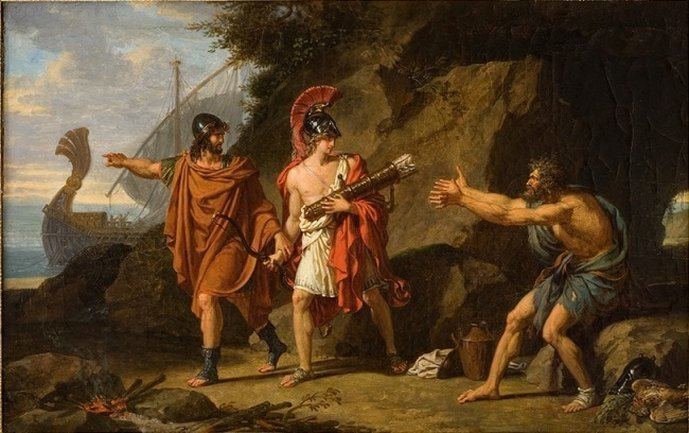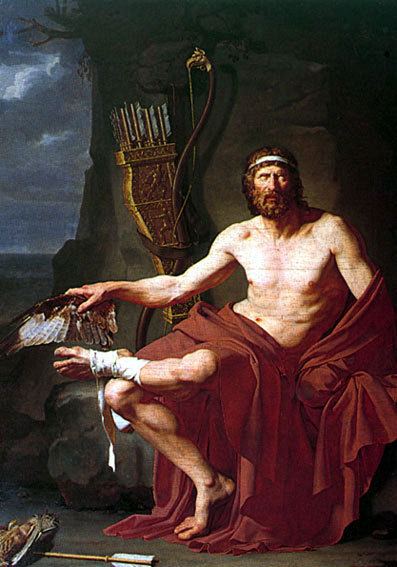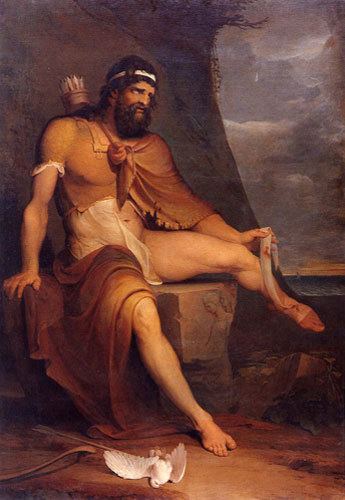 | ||
Play reading sophocles philoctetes
Philoctetes (Greek: Φιλοκτήτης, Philoktētēs; English pronunciation: /ˌfɪləkˈtiːtiːz/, stressed on the third syllable, -tet-), or Philocthetes, according to Greek mythology, was the son of King Poeas of Meliboea in Thessaly. He was a Greek hero, famed as an archer, and a participant in the Trojan War.
Contents
- Play reading sophocles philoctetes
- Philoctetes by sophocles a book review
- The stories
- Drama
- Poetry
- Novels
- Cinema
- Television
- Essays
- Painting
- Sculpture
- References

Philoctetes was the subject of four different plays of ancient Greece, each written by one of the three major Greek tragedians. Of the four plays, Sophocles' Philoctetes is the only one that has survived. Sophocles' Philoctetes at Troy, Aeschylus' Philoctetes and Euripides' Philoctetes have all been lost, with the exception of some fragments. Philoctetes is also mentioned in Homer's Iliad, Book 2, which describes his exile on the island of Lemnos, his being wounded by snake-bite, and his eventual recall by the Greeks. The recall of Philoctetes is told in the lost epic Little Iliad, where his retrieval was accomplished by Diomedes. Philoctetes killed three men at Troy.

Philoctetes by sophocles a book review
The stories
Philoctetes was the son of King Poeas of the city of Meliboea in Thessaly. Heracles wore the shirt of Nessus and built his own funeral pyre. No one would light it for him except for Philoctetes, or in other versions his father Poeas. This gained him the favor of the newly deified Heracles. Because of this, Philoctetes or Poeas was given Heracles' bow and poisoned arrows.
Philoctetes was one of the many eligible Greeks who competed for the hand of Helen, the Spartan princess; according to legend, she was the most beautiful woman in the world. As such, he was required to participate in the conflict to reclaim her for Menelaus in the Trojan War. Philoctetes was stranded on the island of Lemnos by the Greeks on the way to Troy. There are at least four separate tales about what happened to strand Philoctetes on his journey to Troy, but all indicate that he received a wound on his foot that festered and had a terrible smell. One version holds that Philoctetes was bitten by a snake that Hera sent to molest him as punishment for his or his father's service to Heracles. Another tradition says that the Greeks forced Philoctetes to show them where Heracles's ashes were deposited. Philoctetes would not break his oath by speech, so he went to the spot and placed his foot upon the site. Immediately, he was injured in the foot that touched the soil over the ashes. Yet another tradition has it that when the Achaeans, en route to Troy at the beginning of the war, came to the island of Tenedos, Achilles angered Apollo by killing King Tenes, allegedly the god's son. When, in expiation, the Achaeans offered a sacrifice to Apollo, a snake came out from the altar and bit Philoctetes. Finally, it is said that Philoctetes received his terrible wound on the island of Chryse, when he unknowingly trespassed into the shrine of the nymph after whom the island was named (this is the version in the extant play by Sophocles). A modern interpretation of the cause of his wound is that he was scratched by a poisoned arrow. Commonly tips of arrows were poisoned with a combination of fermented viper venom, blood or plasma, and feces. Even a scratch would result in death, sometimes drawn out. A person who survives would do so with a festering wound.
Regardless of the cause of the wound, Philoctetes was exiled by the Greeks and was angry at the treatment he received from Odysseus, King of Ithaca, who had advised the Atreidae to strand him. Medôn took control of Philoctetes' men, and Philoctetes himself remained on Lemnos, alone, for ten years.
Helenus, the prophetic son of King Priam of Troy, was forced to reveal, under torture, that one of the conditions of the Greeks' winning the war was that they needed the bow and arrows of Heracles. Upon hearing this, Odysseus and a group of men (usually including Diomedes) rushed back to Lemnos to recover Heracles' weapons. (As Sophocles writes it in his play named Philoctetes, Odysseus is accompanied by Neoptolemus, Achilles' son, also known as Pyrrhus. Other versions of the myth don't include Neoptolemus.) Surprised to find the archer alive, the Greeks balked on what to do next. Odysseus tricked the weaponry away from Philoctetes, but Diomedes refused to take the weapons without the man. Heracles, who had become a god many years earlier, came down from Olympus and told Philoctetes to go and that he would be healed by the son of Asclepius and win great honor as a hero of the Achaean army. Once back in military company outside Troy, they employed either Machaon the surgeon (who may have been killed by Eurypylus of Mysia, son of Telephus, depending on the account) or more likely Podalirius the physician, both sons of the immortal physician Asclepius, to heal his wound permanently. Philoctetes challenged and would have killed Paris, son of Priam, in single combat were it not for the debates over future Greek strategy. In one telling it was Philoctetes who killed Paris. He shot four times: the first arrow went wide; the second struck his bow hand; the third hit him in the right eye; the fourth hit him in the heel, so there was no need of a fifth shot. Philoctetes sided with Neoptolemus about continuing to try to storm the city. They were the only two to think so because they had not had the war-weariness of the prior ten years. Afterward, Philoctetes was among those chosen to hide inside the Trojan Horse, and during the sack of the city he killed many famed Trojans.
